ENGR 101: Robotics Lecture 6 Follow That Light - PowerPoint PPT Presentation
1 / 12
Title:
ENGR 101: Robotics Lecture 6 Follow That Light
Description:
PBASIC Programming Guide: Writing Programs. BASIC Stamp ... The side sensors look 30 degrees off of center. 2. Lecture 6 Follow That Light! Light Sensors ... – PowerPoint PPT presentation
Number of Views:67
Avg rating:3.0/5.0
Title: ENGR 101: Robotics Lecture 6 Follow That Light
1
ENGR 101 RoboticsLecture 6 Follow That Light!
- Outline
- The Scribbler's Light Sensors
- Using EEPROM Memory
- References
- http//csserver.evansville.edu/richardson/
- Hacker's Hints for the Scribbler Robot
- PBASIC Programming Guide Writing Programs
- BASIC Stamp Syntax and Reference Manual
1
2
Lecture 6 Follow That Light!Light Sensors
- The Scribbler contains three forward looking
light sensors. The particular light sensors used
on the Scribbler are known as Cadmium Sulfide
(CDS) photoresistors. The resistance of a
photoresistor decreases with increasing light
intensity. (The brighter the light the smaller
the resistance.)? - The light sensors are deeply set in the Scribbler
to narrow their focus. The side sensors look 30
degrees off of center.
2
3
Lecture 6 Follow That Light!Light Sensors
- A portion of the Scribbler schematic diagram is
shown on the following slide. - Pins 0, 1 and 2 are connected to the right,
middle and left light sensors respectively. - To determine the light level first take a pin
HIGH. This raises the voltage at the sensor to
almost 5 V. We then change the pin to an input
pin and measure how long it takes the voltage to
fall to 1.4 V using RCTIME.
3
4
Lecture 6 Follow That Light!Light Sensors
4
5
Lecture 6 Follow That Light!Light Sensors
- The syntax for RCTIME is
- RCTIME Pin, State, Variable
- RCTIME changes the direction of Pin to input and
measures how long it takes the Pin to change from
the initial State to the opposite state (High to
Low or Low to High). The time (in units of 2 us)
is stored in Variable (usually a Word variable).
5
6
Lecture 6 Follow That Light!Light Sensors
- The voltage at the light sensor decreases with
time according to the following formula - where V0 is the initial voltage (5 V), Rsensor is
the resistance of the sensor and C is the value
of capacitance. - Solving for t we have
6
7
Lecture 6 Follow That Light!Light Sensors
- The state threshold voltage is 1.4 V, using V0
5 V and solving for the threshold time gives - The sensor resistance decreases with increased
light intensity, so smaller threshold times
correspond to brighter light.
7
8
Lecture 6 Follow That Light!Light Sensors
- The program (01_Light_Sensor.bs2) displays the
RCTIME value for each of the sensors. Download
and run the program. What happens if you cover a
sensor with a finger? - RT_LS PIN 0
- CT_LS PIN 1
- LT_LS PIN 2
- dark VAR Word
8
9
Lecture 6 Follow That Light!Light Sensors
- DO
- HIGH LT_LS
- HIGH CT_LS
- HIGH RT_LS
- PAUSE 3 'Let V rise to 5
- RCTIME LT_LS, 1, dark
- DEBUG CLS, HOME, DEC dark, ", "
- RCTIME CT_LS, 1, dark
- DEBUG DEC dark, ", "
- RCTIME RT_LS, 1, dark
- DEBUG DEC dark
- PAUSE 500
- LOOP
9
10
Lecture 6 Follow That Light!Light Sensors
- You may have noticed that the light sensors are
not identical. To follow a light we need to
track changes in the RCTIME value instead of
comparing absolute levels. - When your program first starts you will need to
record the initial ambient light levels for all
three sensors. - We will explore playing with the light sensors in
our final project.
10
11
Lecture 6 Follow That Light!Using EEPROM Memory
- You can store, read and write values in the 2
kB EEPROM using the PBASIC DATA, READ, and WRITE
commands. Your program is stored at the high end
of the EEPROM so you will normally use low
addresses for storing your own data. - Selecting Memory Map from the Run menu will
display the current memory layout of your
program. (NOT of the actual EEPROM contents.)?
11
12
Lecture 6 Follow That Light!Using EEPROM Memory
- DATA stores values when the program is
downloaded. READ and WRITE are used to access
data when the program is running. - Here is a snippet that prevents your program from
running until RESET is pressed - DATA _at_16, 0 '0 when downloaded
- reset VAR Byte
- READ 16, reset
- IF (reset 1) THEN Main
- WRITE 16, 1 'Write 1 on 1st run
- STOP
12

